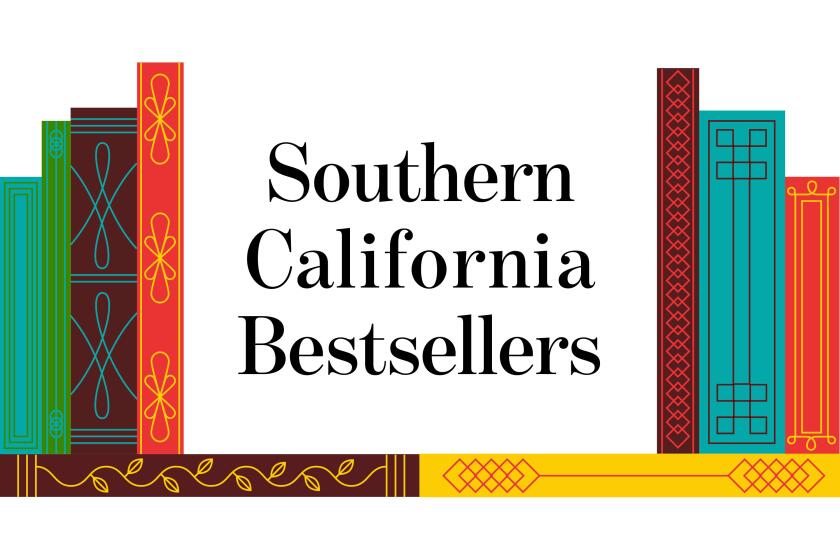Literature Blooms From Latino Roots : Culture: Increasingly, Latino writers are reaching wider audiences as they recount the diversity of their heritage in their own voices.
- Share via
For novelist Elias Miguel Munoz, it’s not a question of whether he should devote his life to writing. “I have no choice but to write,” says Munoz, 37. “I love language. I love words. I love telling stories.”
The Cuban-born author has another, equally compelling, reason for giving up his career as a university professor of literature to spend an average of 10 hours a day writing in his Mission Viejo condominium.
“In my own case, there’s a collective experience of Cubans in the United States that needs to be told,” says Munoz, who left Cuba at 14. “Very little has been written about this experience. I don’t write to make lots of money or to entertain only. As a Latino writer, I feel like I have an important responsibility to help change the way Latinos are seen in the United States.”
Short-story writer Helena Maria Viramontes of Irvine shares that feeling. So does novelist Alejandro Morales of Tustin.
Munoz, Viramontes and Morales are part of a growing chorus of Latino writers in the United States whose voices are beginning to be heard by an increasingly wider audience. And the stories they tell provide welcome insight into Latinos’ diverse experiences in this country:
In his 1988 novel “The Brick People,” Morales tapped his own family’s history to create a fictionalized account of Mexican immigrants who worked in the Simons Brick Factory in Montebello and struggled to find acceptance in their adopted land during the first half of the 20th Century.
In her 1985 short-story collection, “The Moths and Other Stories,” Viramontes focused on East Los Angeles women of various ages as they struggle against the restraints placed on them by a patriarchal Latino society.
And in his new novel “The Greatest Performance,” Munoz traces the lives of best friends Rosa and Mario from childhood in Cuba through immigration to the United States. The novel, which explores such themes as friendship, gender roles and cultural displacement, is gaining recognition as the first U.S. Latino work to deal with AIDS.
The three authors acknowledge that Latino writers in the United States are beginning to enjoy wider attention.
“It’s like all of a sudden we’ve been discovered,” says Munoz, citing the high-visibility successes of such U.S. Latino authors as Oscar Hijuelos (“The Mambo Kings Play Songs of Love”) and Sandra Cisneros (“Woman Hollering Creek”).
“Every minority in the United States has had a moment of arrival, and then they become mainstream. It happened to black writers like Alice Walker, and now, with Amy Tan, the Oriental mythology is becoming accessible through the eyes of a Chinese-American.”
Although the translated works of such Latin American authors as Gabriel Garcia Marquez (Colombia) and Mario Vargas Llosa (Peru) have been best-sellers in this country, Munoz says, “the problem is when U.S. Latinos are compared to them and are expected to produce similar literature. We do have access to that tradition, but what people forget is the conditions of U.S. Latinos are very different from Latin Americans. We’re basically caught between two cultures.”
And that, Munoz says, “is our strength.”
“That gives us the edge in the sense that we’re not afraid to subvert the status quo. Basically, when you’re marginal you have a position of power to--I don’t want to say criticize--but make certain statements and not be afraid. And that power leads to very powerful and rich literature.
“What’s happening with Latino writers is now we’re basically forging our own history, our own tradition. In that sense, we’re the new kid in town.”
Orange County’s Latino writing community includes Cuban-American poet Isa de Quesada, 31, of Huntington Beach. Says De Quesada, who has been writing poetry since she was 11: “I’m real Americanized, so most of my stuff deals with my growing up in America.”
These Latino writers are also involved in other literary activities. De Quesada is associate editor of Onthebus, a literary quarterly; Viramontes co-founded a Los Angeles group called Latino Writers and Filmmakers, and Morales co-founded Pacific Writers Press, a small publishing house whose first book in 1988 was “The New Neighbor and Other Stories” by David Nava Monreal of El Toro.
Morales, a UC Irvine professor of U.S. Latino and Latin American literature, served on a committee that this year established the Orange County chapter of PEN, the international writers organization. The chapter’s first president is Argentine-born poet and critic Florinda Mintz of Santa Ana.
Morales also works with the annual Chicano/Latino Literary Contest, a prestigious national competition started 18 years ago that is sponsored by UCI’s Department of Spanish and Portuguese.
But writing remains the Latino authors’ highest priority.
“I think we’re at the beginning of a renaissance of Latino writers in the United States,” observes Morales, noting that the civil rights movement of the ‘50s and ‘60s--a time when various ethnic groups began to address their particular situations through writing--served as a foundation for today.
Crucial to their success, Morales says, “are the small presses, which for years have allowed these silent voices to express themselves.”
Which is why a small publishing house affiliated with the University of Houston--Arte Publico Press--has been so important to the careers of not only Morales, Munoz and Viramontes but also of hundreds of other Latino writers. It is the largest and oldest publisher of Latino literature in the United States.
“Our mission is to get Hispanic writers into the mainstream and to have the United States recognize its Hispanic heritage as part of the official national identity,” says Nicolas Kanellos, founder and publisher. Arte Publico Press, which published its first book in 1979, now publishes about 25 titles a year.
Because it is small, Kanellos says, the publisher must turn down hundreds of deserving manuscripts.
It’s even more difficult for Latino writers to break into New York publishing circles. Indeed, Kanellos says that although a few U.S. Latino writers have achieved mainstream success, they are the exceptions. For the vast majority, the doors of the major New York publishing houses remain virtually closed.
“First of all, they don’t know Hispanics in the U.S.,” he says. “They live in a very closed society and they’re still very Eurocentric. They think when you say Hispanic, that (Hispanics) mostly speak Spanish, not English. They also think that Hispanics are illiterate and that mainstream Americans are not interested in their literature or in reading about them.”
And yet, Kanellos says, both the publishing and entertainment industries have profited from Latino stereotypes since the dime novel days of the late 19th Century and D. W. Griffith’s silent movies through television’s “The Cisco Kid” in the ‘50s and contemporary films about gangs and drugs, such as “Colors.”
But such stereotypes clash with the idea of publishing “a Latino intellectual or artistic creator,” says Kanellos. “The message is completely contrary. On the one hand, they’re showing crime and poverty and ignorance, and on the other hand they would have to be showing intelligence and continuing a large multinational tradition that has excelled in literature since the time of Cervantes.”
Kanellos concedes, however, that mainstream publishers’ attitudes are beginning to change.
“There are some chinks in the armor,” he says, mentioning the mainstream breakthroughs by authors who have come up through the small Latino presses: 1990 Pulitzer Prize winner Hijuelos and Cisneros, who was published by Arte Publico Press before moving to Random House.
Victor Villasenor of Oceanside is one of the most visible U.S. Latino authors. His epic account of his family’s migration from Mexico to California, “Rain of Gold,” was published by Arte Publico Press in August.
(Villasenor originally signed with Putnam but returned his $75,000 advance and sought out Arte Publico after Putnam insisted on labeling his book fiction and changing its title. Villasenor’s account of three generations of his family was Arte Publico’s first hardcover release (with a first printing of 30,000 copies) and has been called a Latino “Roots.”)
In Kanellos’ view, Latino literature in the United States is “probably the most important American literature at this time in history.”
Not only is it expressed in the two major languages of the hemisphere, Spanish and English, he says, but “because of the diverse Latino populations, it includes in some of its manifestations African background and culture, native American (background). And it is part of the Anglo-American experience as well.”
It is, he maintains, “the best postmodernist literature that can be found because it summarizes everything that Americans are as a people and the potential Americans have in becoming a totally integrated hemisphere.”
Viramontes, who is working on her second short-story collection, “Paris Rats in East LA,” recently spoke before a group of 450 university-bound Latino community college students at UC Irvine, where she received a standing ovation.
“That was the first time I actually felt like a rock star,” she said with a laugh, adding, “That’s the sort of reverence they have for the written word.”
Says Morales: “At one time the Latino community was viewed only as working class, but now you have people in the middle class and the upper class. We have people in a sense moving out of the ghettos and moving to more affluent areas.
“All those experiences need to be told, and I think you’ll find they will be told.”
More to Read
Sign up for our Book Club newsletter
Get the latest news, events and more from the Los Angeles Times Book Club, and help us get L.A. reading and talking.
You may occasionally receive promotional content from the Los Angeles Times.










